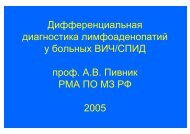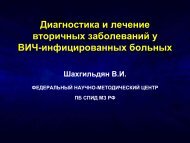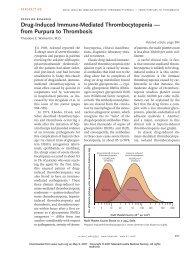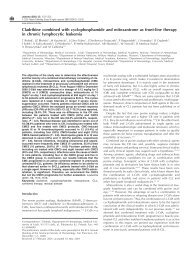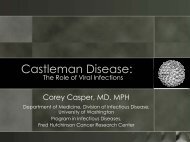ANCA-associated Vasculitis - Hem-aids.ru
ANCA-associated Vasculitis - Hem-aids.ru
ANCA-associated Vasculitis - Hem-aids.ru
Create successful ePaper yourself
Turn your PDF publications into a flip-book with our unique Google optimized e-Paper software.
Ozaki S<br />
cyclophosphamide should be reduced to 7550%. Remission<br />
is evaluated by the BVAS, and, in general,<br />
can be achieved within 6 months. Patients who have<br />
attained remission receive maintenance therapy for<br />
an additional 1 year. This includes prednisolone (5 to<br />
10 mgday), and in most cases oral cyclophosphamide<br />
or azathioprine (25 to 75 mgday). 7<br />
(b) Generalized MPAmost severe form: This<br />
form is defined as patients with either diffuse alveolar<br />
hemorrhage, intestinal perforation, acute pancreatitis,<br />
cerebral hemorrhage, concurrent anti-GBM antibodies,<br />
or resistant severe disease. Patients with this<br />
form of MPA are treated with plasmapheresis (2.0 to<br />
3.0 Lday for 3 days; several sessions) together with<br />
the standard regimen described above. After induction<br />
of remission, patients receive the same maintenancetherapyasthesevereformfor1year.<br />
(c) Limited MPAmild form: This form includes a<br />
renal-limited type (except RPGN), a pulmonarylimited<br />
type (except pulmonary hemorrhage), and<br />
other mild forms. To induce remission, patients receive<br />
oral prednisolone (0.3 to 0.6 mgkgday; 15 to<br />
30 mgday). Oral immunosuppressive agents (cyclophosphamide<br />
or azathioprine; 0.5 to 1.0 mgkgday;<br />
25 to 75 mgday) can also be considered. Maintenance<br />
therapy after induction of remission is similar<br />
to that in the generalized form.<br />
PROSPECTIVE TRIAL FOR MPA IN JAPAN<br />
JMAAV TRIAL<br />
To establish evidence for Japanese patients with<br />
MPO-<strong>ANCA</strong>-<strong>associated</strong> vasculitis, the standard protocols<br />
for MPA mentioned above have been evaluated<br />
in a prospective, open-labeled, and multi-center manner.<br />
The Research Group of Intractable <strong>Vasculitis</strong> and<br />
that of Progressive Glome<strong>ru</strong>lar Disease, MHLW of Japan,<br />
organized a study group, named the Japanese<br />
Study Group for MPO-<strong>ANCA</strong>-<strong>associated</strong> <strong>Vasculitis</strong><br />
(JMAAV), which included 27 centers from throughout<br />
the country. 26 In this trial, patients with newly diagnosed<br />
MPA were stratified into those with the severe<br />
form, most severe form, or mild limited form of<br />
the disease, as defined above. Patients received the<br />
regimen according to the therapy protocol, and were<br />
followed up for 18 months. The protocol for the severe<br />
form is illustrated in Figure 1. The primary end<br />
point was induction of remission, and the rates of severe<br />
adverse effects, including death and end-stage<br />
renal failure, were also evaluated. As secondary end<br />
points, the effectiveness and safety of the standard<br />
protocols were evaluated. Furthermore, peripheral<br />
blood was collected from all assigned patients before<br />
and 7 days after the start of initial treatment, and the<br />
expression profiles of genes in peripheral blood cells<br />
were analyzed using cDNA chips. This comprehensive<br />
transcriptome analysis will reveal the key genes<br />
<strong>associated</strong> with the onset of disease or the prediction<br />
of remission. The enrollment of patients was completed<br />
at the end of September 2006, and 52 patients<br />
were enrolled. The follow-up and intensive analysis of<br />
patients are currently underway.<br />
TREATMENT OF WEGENER’S GRANULOMATO-<br />
SIS (WG)<br />
(a) Generalized WG: To induce remission of this<br />
form of WG, prednisolone (40 to 60 mgday) and cyclophosphamide<br />
(50 to 100 mgday) are administered<br />
orally for 8 to 12 weeks. In cases of a renalpulmonary<br />
type (including pulmonary hemorrhage)<br />
or RPGN type disease, a regimen similar to those for<br />
generalized MPA (severe form) is employed. In patients<br />
intolerant of cyclophosphamide due to adverse<br />
effects, azathioprine (50 to 100 mgday) or methotrexate<br />
(2.5 to 7.5 mgweek) is used. After induction<br />
of remission, patients receive maintenance therapy:<br />
tapering dose of prednisolone, which is stopped<br />
within 8 to 12 weeks, plus cyclophosphamide (25 to<br />
50 mgday), or prednisolone only (5 to 15 mgday)<br />
without cyclophosphamide. 8<br />
(b) Limited WG: To induce remission of early and<br />
active disease, prednisolone (15 to 30 mgday), cyclophosphamide<br />
(25 to 75 mgday), and sulfamethoxazoltrimethoprim<br />
(2 to 3 tabletsday) are administered<br />
orally for 8 weeks. In patients intolerant of cyclophosphamide<br />
due to adverse effects, azathioprine<br />
(25 to 75 mgday) or methotrexate (2.5 to 7.5 mg<br />
week) is used. Maintenance therapy after induction<br />
of remission is similar to that in the generalized form.<br />
TREATMENT OF ALLERGIC GRANULOMATOUS<br />
ANGIITIS (AGA)<br />
Induction of remission can be achieved using corticosteroids.<br />
After intravenous methylprednisolone<br />
(0.5 to 1.0 gday for 3 days), prednisolone (40 mg<br />
day) is administered orally for 8 weeks. Prednisolone<br />
is then tapered under careful monitoring of clinical<br />
symptoms and laboratory findings (especially eosinophil<br />
counts). Patients with active angiitis can receive<br />
cyclophosphamide or azathioprine (50 to 100 mg<br />
day). 9 Asthma is treated as usual.<br />
NOVEL THERAPIES OF AAV<br />
The three RCT described above 15-17 yielded induction<br />
of remission at rates of approximately 90%. Therefore,<br />
t<strong>ru</strong>e “cyclophosphamide resistance,” which is defined<br />
as the presence of active disease affecting a major organ<br />
despite optimal doses of daily cyclophosphamide<br />
and corticosteroids, is rare in AAV. Clinical situations<br />
labeled cyclophosphamide resistance are often due to<br />
failure to distinguish correctly between active disease<br />
and what may present with manifestations similar to<br />
active disease, such as permanent damage, the presence<br />
of other diseases, or the development of medication<br />
toxicities (e.g., infections). These conditions<br />
should be <strong>ru</strong>led out carefully to judge t<strong>ru</strong>e “cyclophosphamide<br />
resistance”, for which various novel<br />
6 Allergology International Vol 56, No2, 2007 www.jsaweb.jp



